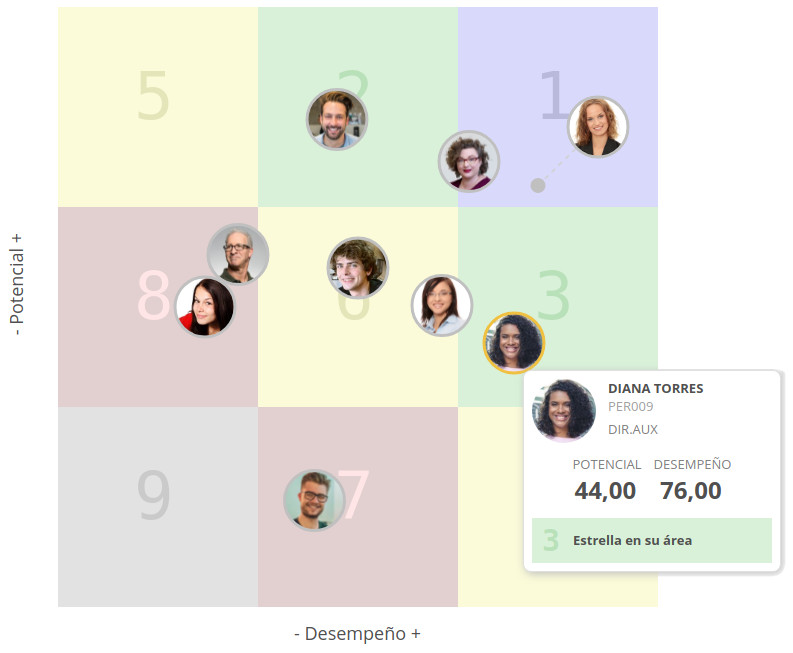High potential employees are one of the most valuable assets of companies. So much so that
high-potential employees bring 91% more value to the organization. High-potential people grow fast, aspire to a higher-level position, continually train, and are key contributors to succession planning.
But let's go step by step to be clear about how to detect and work with the potential of our organization:
What is employee potential?
A person's potential is the talent that has not yet been materialized in a consolidated way with the possibility of developing it. Each person has their own strengths and can therefore create better value for the organization.
A high-potential employee has the ability, aspiration, and commitment to exceed the requirements and expectations of their current competencies and/or goals, or even to occupy leadership positions in the future. And what is the key? The key is to carry out well-managed talent management so that high potentials see a future for themselves in your organization. In other words, that talent does not go unnoticed and that everyone feels fulfilled.
Initiative
Commitment
Aspiration
Hungry for knowledge
· Search for positive and negative feedback
· A certain dose of non-conformity and a great desire to excel
However, even though companies have
between 3% and 5% of high potentials and while they demonstrate good aptitude and will be able to do much more for the organization in the long run, these people often go unnoticed.
How to measure employee potential?
If we ask a collaborator if he is ready to handle new responsibilities, it is very likely that he will say yes without hesitation. And even from HR it may seem like he's up to it, but what if when he starts on those new tasks something starts to go wrong?
The solution is easy: measure the competencies related to that new position or the new responsibilities, as well as the skills that may be needed, such as interpersonal ones. To measure the potential, we will have to take into account several aspects:
-
Characteristics of the role: The potential evaluation process begins with the definition of the characteristics and dimensions of the role of the employee whose potential is to be evaluated. The job description helps us to understand the responsibilities and competencies that must be known to fill the position. If we regularly evaluate performances, you already have that information through the evaluation models -questionnaires- that you create to evaluate each position in the organization.
-
Create an evaluation model*: Once we have the characteristics of the role, we can evaluate the potential of the employee. To do this, we will have to put the information that we previously collected into a model with which the evaluator can determine the potential of the evaluated employee.
-
Individual action plan: with the reports already consolidated we can assign new challenges and actions to make the most of the potential of the evaluated individual, according to the key skills we are looking for to develop or stand out.
-
360º feedback: reports without feedback are meaningless. In addition to the evaluation of potential, the best thing for effective feedback is to also have the perspectives of peers and people in charge to obtain a more complete picture of potential of each individual.
How is the potential applied?
After evaluating the potential, we have to work with the data:
-
Continuous performance evaluation: Regularly evaluating performances ensures that we always have the necessary and updated information to create opportunities (we are constantly changing!). And, of course, to keep on detecting and taking care of the potential of our organization.
-
Correlation of Potential with Evaluation: Identifying people with high potential will help us with their development, but not everything is potential. In order to consolidate the results and make the best strategic decisions, we can link the evaluation of potential with performance to create a talent map. A talent map allows us to locate each individual from the organization and know where each one is. This information is extremely valuable in order to make decisions that are fairer, more transparent and more agile.

High potential people are not only more motivated and help drive the organization forward, they also increase
the productivity by up to 15% of your peers. Getting the most out of your high-potentials will create satisfied employees, a productive team, and have a positive impact on the company as a whole, leading to long-term growth.
*At Hrider we have a Library of Templates for you to evaluate Potential, Leadership, Performance, Climate & Culture and much more. We can also provide you with a Potential Assessment model below that will help you identify high-potential people in your organization. Download it for free and take advantage of the potential of your organization!:
Get Potential template